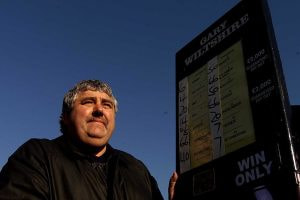The Biggest Football Stadiums in England and the World
Football as a sport has the potential to bring different people from different corners of the world, uniting diverse cultures, promoting peace and connecting people. In addition, the sport generates enormous amounts of money, with the record amount paid for a sports team expected to be broken if Manchester United are sold this summer for a reputed £6 billion. The potential buyers will need deep pockets to give Old Trafford a modern makeover.

With the colossal money around the sport and football betting, investing heavily in the arena where it is played makes sense. The desire for bigger and better stadiums has led to some classic and iconic infrastructure. So join us as we explore the biggest stadiums in the world.
Here is a list of some of the biggest football stadiums in the world.
Rungrado May Day Stadium
Wembley Stadium is too small for Davido.
Give us Rungrado May Day Stadium.
Don’t play. pic.twitter.com/QOB3lUbb80
— Thεό Abu (@TheoAbuAgada) March 8, 2022
The unique multipurpose arena is arguably the biggest football stadium in the world despite not being primarily built for the sport. The stadium opened in 1989 and is on over 21 hectares of land.
Given the dimensions, it is understandable that the arena is multifunctional mainly because North Korean football doesn’t have the best league and isn’t entirely fascinated by the sport. However, that doesn’t remove any excellence from the structure made feasible by a scalloped roof with several exquisite details.
The Rungrado stadium serves as the North Korean national team’s home field; it also hosts a variety of non-football activities throughout the year.
Like the nation, virtually little is known about the stadium, including building expenses.
The scalloped top of the stadium has 16 arches grouped in a ring and is designed to mimic a magnolia bloom. It holds events on a main pitch measuring 22,500 m2 (242,000 sf).
It has eight floors and a total area of more than 207,000 m2 (2,230,000 sq ft), with the roof’s lobes reaching a height of more than 60 m (200 ft).
The initial design was to build a 150,000-person capacity. However, a renovation in 2014 replaced some bench seats with more exclusive individual seats, which reduced the arena to a new total of around 114,000.
It was Asia’s most prominent and world’s largest stadium ever constructed when it was finished. Kim Jong-un and other principal Workers’ Party of Korea officials presided over a New Year’s Eve concert performed on the stadium’s grounds on December 31 2022.
Location: Pyongyang, North Korea
Opened: 1989
Seating Capacity: 114,000
Construction Cost: £152 million(estimated)
Melbourne Cricket Ground
The ☀️ is back out Melbourne!
What better place to be than the ’G for tonight’s clash between @CarltonFC and @GeelongCats. Visit https://premier.ticketek.com.au/shows/Show.aspx?sh=CARLT0223 to secure your seat. pic.twitter.com/fZTozl1vPH
— Melbourne Cricket Ground (@MCG) March 23, 2023
One of the most recognisable athletic venues worldwide is the Melbourne Cricket Ground, and it certainly holds its own compared to the biggest European football stadiums.
The colossal stadium’s fame is accredited to the multifunctional nature of the facility, with the ability to host both football and cricket matches successfully.
The venue has grown significantly in popularity over the years due to hosting all significant events. For example, Australian Rules Football games, Olympic events, and World Cup qualifications have taken place at the MCG, as it is known. It was built and operated by the Melbourne Cricket Club.
The arena is the second-biggest cricket venue in capacity, the largest stadium in the Southern Hemisphere, and the 11th largest worldwide.
The Richmond and Jolimont railway stations, route 70, route 75, and route 48 trams, and the city centre are all within walking distance of the MCG. It is a Melbourne Sports and Entertainment Precinct component located next to Melbourne Park.
The MCG has undergone ongoing renovations to be current with contemporary needs because it has been around for a long time. The most recent significant restoration occurred in 2006 and ran up costs that many brand-new stadiums would baulk at.
A resilient arena that stood strong enduring several disasters like World War II and yet holds onto its status as one of the biggest football stadiums in the world.
The Melbourne Cricket Ground (MCG) has hosted several famous events, including the 1992 and 2015 ICC Cricket World Cup finals, the AFL Grand Final, the Olympic Games in 1956 and 2006, and the 2015 AFC Asian Cup final in football.
The venue is also popular with the biggest names in music. U2, Madonna, and the Rolling Stones have all played concerts at the venue.
Location: East Melbourne, Australia
Opened: 1853
Seating Capacity: 100,024
Construction Cost: £331 million
Camp Nou
Spotify Camp Nou > pic.twitter.com/P0nzxO7STj
— FC Barcelona (@FCBarcelona_cat) March 19, 2023
One of the biggest stadiums in the world, Camp Nou, is home to FC Barcelona. With a capacity of approximately 100,000, It is one of the biggest football stadiums in Spain and one of the biggest football stadiums in Europe.
The capacity is a landmark accomplishment for an all-seat stadium, as most stadiums have standup corners that boast the stadium’s capacity.
Throughout its history, Camp Nou has hosted countless iconic events and games, including the Champions League finals, World Cup matches, Summer Olympics, and European Nations Cup.
One of the most costly remodelling projects—the most recent additions and upgrades—cost more than £528 million. However, even after investing enormous sums of money, Camp Nou is still one of the best stadiums in Europe without a roof covering most areas.
FC Barcelona has announced that it will undertake a significant renovation project at the historic Spotify Camp Nou stadium, with an impressive budget of $966 million. The renovations are set to commence in June 2023, with completion expected by June 2026. This overhaul is one of the most extensive in the stadium’s history and aims to enhance the fans’ experience while maintaining the stadium’s iconic status.
The renovation project has been made possible due to the long-term sponsorship deal secured with Spotify. The stadium was rebranded as the Spotify Camp Nou as part of this deal. Additionally, the club has agreed to deals with private equity firms to sell a 10% stake in its TV rights worth up to $278 million and sell stakes in its media production arm for $102 million each.
The renovation project will include several enhancements to the stadium, such as improving the acoustics, adding new VIP boxes and lounges, and upgrading the media facilities. The club has also indicated that the project will include an eco-friendly approach, with renewable energy sources being implemented to power the stadium.
Location: Barcelona, Spain
Opened: 1957
Seating Capacity: 99,354
Construction Cost: £793 Million
FNB Stadium
The FNB Stadium is the largest stadium of its sort in Africa. It primarily hosts rugby union and football matches. Given its vastness, it may be a rather daunting site.
The venue has served a variety of functions in the past, but it is most known for hosting the 2010 World Cup final game between Spain and the Netherlands.
The local Kaizer Chiefs (the team, not the music band from Leeds!) and South African national teams play their home matches at the FNB Stadium. It is definitely among the top 10 biggest football stadiums in the world. The stadium is especially noteworthy since it hosted Nelson Mandela’s final public appearance.
Even though the stadium has existed since 1987, extensive renovations in 2010 in preparation for the World Cup resulted in several new amenities, such as executive suites, a new roof, floodlights, and changing rooms.
One of the most notable football matches played at the FNB Stadium was the final of the FIFA World Cup in 2010, which Spain won after defeating the Netherlands 1-0. The stadium has also been used for the Africa Cup of Nations, with ten matches played during the 1996 competition, including the final, which South Africa won. In addition, the FNB Stadium hosted the 2013 Africa Cup of Nations Final, which saw Nigeria defeat Burkina Faso 1-0.
The Local Organising Committee for the 2010 FIFA World Cup and the FIFA offices are both based nearby in SAFA House, the administrative centre of the South African Football Association.
The FNB Stadium, which can hold 94,736 people, was built to be the primary association football venue for the World Cup. It is now the largest stadium in Africa. Nevertheless, because of allocated seats for the press and other VIPs, it could only hold 84,490 people for the 2010 FIFA World Cup.
Due to the stadium’s resemblance to an African pot or gourd, it is sometimes referred to as “The Calabash” by fans.
Location: Johannesburg, South Africa
Opened: 1989
Seating Capacity: 94,736
Construction Cost: £320 Million
Wembley Stadium
Iconic football moment when Higuita invented the Scorpion kick against England in 1995 at Wembley stadium pic.twitter.com/H9ICvFaR85
— Tansu YEĞEN (@TansuYegen) March 18, 2023
Football fans in England frequently travel to Wembley, one of England’s biggest football stadiums and considered the “Mecca” for English football.
The decision by the English Football Association to demolish Wembley, widely considered the home of football, in favour of a new stadium was met with a great deal of scepticism when it was announced. However, the famous “twin towers” was demolished in 2002 and the “new Wembley” opened in 2007.
However, the upgrade didn’t come cheap, with an extravagant price tag of approximately £800 million, equating to a sum of £1.3 billion in today’s value.
It is one of the significant locations where international games are played and the home of the England national team. In addition, the League Cup, FA Cup, and several other lower-league tournaments are now played at Wembley. It is also the location of several events and concerts.
| Stadium | Capacity |
|---|---|
| Wembley Stadium | 90,000 |
| Old Trafford | 76,000 |
| Tottenham Hotspur Stadium | 62,062 |
| Emirates Stadium | 60,260 |
| Etihad Stadium | 55,017 |
| Anfield | 54,074 |
| London Stadium | 60,000 |
| St James’ Park | 52,354 |
| Villa Park | 42,682 |
| Stamford Bridge | 40,834 |
The stadium, created by Populous and Foster and Partners, is topped by the 134-meter-high (440-foot) Wembley Arch, which also acts as a landmark for London and provides structural support for more than 75% of the roof weight.
In addition, to let the sunshine in and promote pitch growth, two partially retractable roof structures over the east and west ends of the stadium may be opened.
The stadium is the biggest in its category and can accommodate 90,000 people under one roof. This makes it one of the UK’s biggest football stadiums. In its recent existence,
Wembley has previously hosted important events like the Champions League final. As a result, Wembley is arguably the creme de la creme among the biggest England football stadiums.
Location: London, England
Opened: 2007
Seating Capacity: 90,000
Construction Cost: £695 million
Estadio Azteca
The Stadium Azteca, home of Club America, Cruz Azul, and the Mexican national team, is a recognisable sight in Mexico City.
The prestige of hosting two World Cup finals in 1970 and 1986—is one of the primary causes of the stadium’s extensive history.
Diego Maradona’s notorious “Hand of God” goal against England in the 1986 World Cup was another legendary incident in football history in this stadium.
An unforgettable goal 🧐
Diego Maradona’s ‘Hand of God’ goal against England will forever go down in #FIFAWorldCup history 🇦🇷
— FIFA World Cup (@FIFAWorldCup) November 11, 2022
The game between West Germany and Italy in 1970 was also played in Stadium Azteca. This match, known as the “Game of the Century,” saw Italy triumph with a score of 4-3 following extra time.
The Estadio Azteca is the only football arena in the world where two of the game’s best players, Diego Maradona in 1986 and Pelé in 1970; both won the FIFA World Cup.
With the potential to host the World Cup 2026 games, Stadium Azteca may continue to adorn its hat with further achievements.
In addition to hosting the World Cup in the past, Estadio Azteca has also hosted the Summer Olympics and the Women’s World Cup. Also, as part of its International Series, the National Football League (NFL) hosts one game at Estadio Azteca each season.
Even now, the stadium has yet to begin to show its age because repeated renovations have continually introduced new amenities like LED panels and recreational areas. In addition, executive boxes have just been added, bringing the capacity down to the low 87,000s.
Location: Mexico City, Mexico
Opened: 1966
Seating Capacity: 87,525
Construction Cost: £9.7 million
Borg El-Arab Stadium
The Borg El-Arab Stadium is also known as the Egyptian Army Stadium or El-Geish Stadium in Alexandria. It was opened in 2005 in the Egyptian resort town of Amreya, located 25 kilometres west of Alexandria.
In terms of overall capacity, this stadium is only second to the FNB Stadium on the African continent.
The Borg El-Arab Stadium is by a comfortable margin the biggest in Egypt, with a capacity of 86,000. Moreover, it is the ninth-largest association football stadium worldwide.
It is 10 kilometres from Borg El Arab Airport and 15 kilometres from Alexandria’s downtown on the Cairo-Alexandria desert route.
In contrast to many other stadiums, it has been air-conditioned in numerous locations to resist the harsh weather conditions in this region effectively.
The stadium’s designers made a significant effort to ensure it offers every facility. They included two more minor stadiums holding up to 2,000 people each. A jogging track surrounds the surface, and the property has four floodlights.
There is only one stand with a roof over it. A 200-room hotel is also located inside the stadium.
It is the home stadium for the Egypt national football team. It just entered the pages of history as Egypt used it to advance to the World Cup for the first time since 1990. The Borg El-Arab Stadium features a football field, jogging tracks, and other areas for Olympic Games sports.
Location: Borg El-Arab, Egypt
Opened: 2009
Seating Capacity: 86,000
Construction Cost: £176 million
Bukit Jalil National Stadium
Even though the Malaysian national football team is not ranked highly by FIFA, the country is nevertheless developing one of the biggest football stadiums in the world.
The RM800 million Bukit Jalil National Stadium is a behemoth with a capacity of more than 87,000 people. It is Southeast Asia’s biggest stadium of its sort. Therefore, it should not be surprising that it has hosted several other occasions besides the national team of Malaysia’s games. The Southeast Asian Games, the Commonwealth Games, and other events occurred in the Bukit Jalil National Stadium.
Today, it also serves as the site for the majority of Malaysia’s international football matches, as well as athletic competitions, music concerts, and national-level football competition finals like the Malaysia FA Cup and Malaysia Cup.
This multisport facility has a roof and is made primarily of reinforced concrete. Although it is relatively new, much renovation work has already been done. It includes much-needed upgrades like contemporary amenities and LED lighting. Retractable seats, a retractable roof, and lifestyle amenities are among the additional elements that will be added to the stadium as part of future renovations. In addition, the report below shows that VAR will be installed at the stadium soon.
The use of VAR, equipped with a minimum of eight cameras, is deemed suitable for the National Stadium.#theSun #theSundaily #football #technology #Malaysia #VAR https://thesun.my/sport/psm-plans-to-equip-national-stadium-in-bukit-jalil-with-var-system-BB10776575
— theSun (@theSundaily) March 21, 2023
On July 11 1998, Tun Dr Mahathir Mohamad, Malaysia’s fourth prime minister, gave it its formal opening.
It was planned by Arkitek FAA, Weidleplan Consulting GMBH, and Schlaich Bergermann Partner and constructed by United Engineers Malaysia. It was built alongside other sporting arenas at the National Sports Complex. The roof is made of a membrane construction, with reinforced concrete making up most components. Stadium Merdeka served as Malaysia’s national stadium before its opening.
Location: Wilayah Persekutuan Kuala Lumpur, Malaysia
Opened: July 11 1998
Seating Capacity: 85,000
Construction Cost: £129 million
Signal Iduna Park
The stadium is renowned for its atmosphere with Europe’s most passionate football fans. It is one of the biggest football stadiums in Germany.
Still, it is more famous for the hostile environment of the opposition, but a beautiful and memorable spectacle for a football match. It is the home of Borussia Dortmund, with wears a yellow jersey, thus the name the ‘yellow wall’.
The 1974 World Cup was held in one of the stadiums erected in 1974, Signal Iduna Park. Visiting teams and their supporters may feel intimidated by the stands’ proximity to the field. The stadium is also home to the biggest free-standing stand in Europe, with a capacity of 25,000 people. The “Yellow Wall” is another name for this concession stand.
The Südtribüne at Borussia Dortmund’s Signal Iduna Park, known as the Yellow Wall, is an impressive sight, with 328ft of length and 131ft of height, packing in enough people to make up a town. Every home Bundesliga game draws close to 25,000 supporters from all walks of life, producing a boisterous, roaring town of Schwarzgelben souls that can cause rival teams to wither and BVB’s best to bloom. The Yellow Wall is one of the most recognisable stands in football history thanks to a mix of fan support and architecture. The Yellow Wall is a singular phenomenon that fills individuals who stand within its embrace with pride and sends shivers down the spines of those who observe it from the outside.
Signal Iduna Park is one of Europe’s largest stadiums. It hosted several games at the 1974 and 2006 World Cups. Also held there was the UEFA Cup Final in 2001.It is the largest stadium in Germany and the seventh-largest stadium in Europe. It holds the record for average fan attendance in Europe, with an average of 80,588 spectators per game over its 17 games in the 2011–12 season.
Location: Dortmund, Germany
Opened: 1974
Seating Capacity: 81,365
Construction Cost: £176 million
Old Trafford
The infamous Old Trafford is one of the biggest football stadiums in the UK. The home of Manchester United, it is located in Old Trafford, Greater Manchester, England.
With a seating capacity of 74,310, it is among the top 10 biggest football stadiums in England and the eleventh-largest in Europe. Moreover, it is the second-largest, only behind Wembley Stadium, in the biggest English football stadiums list.
It is roughly 0.5 miles (800 m) from Old Trafford Cricket Ground and the neighbouring tram station.
Since 1910, United has called Old Trafford home; however, due to Second World War bomb damage, the team shared Maine Road with nearby rivals Manchester City from 1941 until 1949.
A former Manchester United player, Bobby Charlton, referred to Old Trafford as the “Theatre of Dreams.” This nickname has become synonymous with the stadium and is still used today. Bobby Charlton won numerous titles and awards during his time at Manchester United. He contributed significantly to the 1968 European Cup winning squad, scoring twice against Benfica in the final. He also won three English First Division titles with United, one FA Cup, and the Charity Shield four times. Individually, he won the Ballon d’Or in 1966 and was named Football Writers’ Association Footballer of the Year twice. Charlton is regarded as one of the greatest players in Manchester United and England’s history.
Throughout the 1990s and 2000s, Old Trafford underwent several upgrades, including installing additional levels to the North, West, and East Stands, nearly restoring the stadium to its original seating capacity of 80,000. In so doing, it became among the UK’s most prominent football stadiums.
In addition, the South Stand will probably have a second deck for future construction, increasing its capacity to about 88,000. It is a move that will cement its position among England’s top 10 biggest football stadiums. However, there has been talk about knocking down the stadium and rebuilding either on the same site or nearby. This need for development has made the current owners consider selling the club.
🇶🇦🚨Qatari Group Offer Explained
€5.8B for 100% of #mufc
€1.5B for the renovation of the stadium, the training center and the area around Old Trafford.
€2B invested in transfers and recruiting the best staff for the team in the next 3 seasons.
All debts paid. pic.twitter.com/G99fowXYm0— Man United Latest (@TheUtdLatest) March 22, 2023
Although Manchester United are a household name with a global fan base, an interesting stat is that Old Trafford’s record attendance of 76,962 was for a game that didn’t feature the Red Devils. The record was for an FA Cup semi-final between Wolverhampton Wanderers and Grimsby Town in 1939.
Along with being the home to Manchester United, Old Trafford is no stranger to hosting international events. In the 1966 World Cup, three group matches were held at the stadiums, including the quarter-final between Argentina and England. The 2003 UEFA Champions League Final between AC Milan and Juventus was also held at the venue.
Apart from football, it has been the location for the Rugby League World Cup finals in 2000, 2013 and 2022, and every year’s Super League Grand Final, except for 2020.
Location: Greater Manchester, England
Opened: 1910
Seating Capacity: 74,310
Construction Cost: £1.2 billion
The Rose Bowl Stadium
The Rose Bowl Stadium in Pasadena, California, has a significant history of hosting notable soccer games, such as the 1994 FIFA World Cup Final, in which Brazil won against Italy on penalties, securing their fourth World Cup title.
Additionally, the stadium hosted the 1999 FIFA Women’s World Cup Final, where the United States emerged as the champions by defeating China on penalties. It was also the venue for the soccer events of the 1984 Summer Olympics, including the Olympic Soccer Gold Medal Match. Moreover, the Rose Bowl has hosted various other soccer matches, including CONCACAF and United States Soccer Federation matches.
Recently, FIFA declared that Los Angeles would serve as a host city for the 2026 World Cup and the Rose Bowl Stadium was selected as one of the venues for the games.
Rose Bowl Stadium, Pasadena pic.twitter.com/goybpsGuqV
— Mo Foroughi (@MoForoughi) March 15, 2023
Due to its rich history, the stadium is regarded as one of the most well-known soccer venues in the United States and is one of the biggest college football stadiums.
The United States men’s national soccer team has played 17 games in the Rose Bowl, the fourth most of any venue. The Rose Bowl Stadium also hosts the annual Rose Bowl Game and has hosted 5 Super Bowls, the second-highest number for any venue.
The stadium has undergone many renovations since its construction in 1922, including the addition of the Terry Donahue Pavilion and the 1922 Locker Room Museum. In 1999, Sports Illustrated listed the Rose Bowl as number 20 in the Top 20 Venues of the 20th Century, and in 2007, it named the Rose Bowl the number one venue in college sports.
Location: Pasadena, California, USA
Opened: 1922
Seating Capacity: 92,542
Construction Cost: Unknown
In conclusion, football stadiums are not just places where games take place. They are the spiritual homes of the teams that play there, and supporters often hold fond memories of visiting (or not so fond if their team lost!). We hope you’ve enjoyed our overview of the biggest football stadiums in England and worldwide; visiting as many of these venues as possible is on our bucket list. The Rose Bowl in 2026 for the World Cup definitely appeals!



